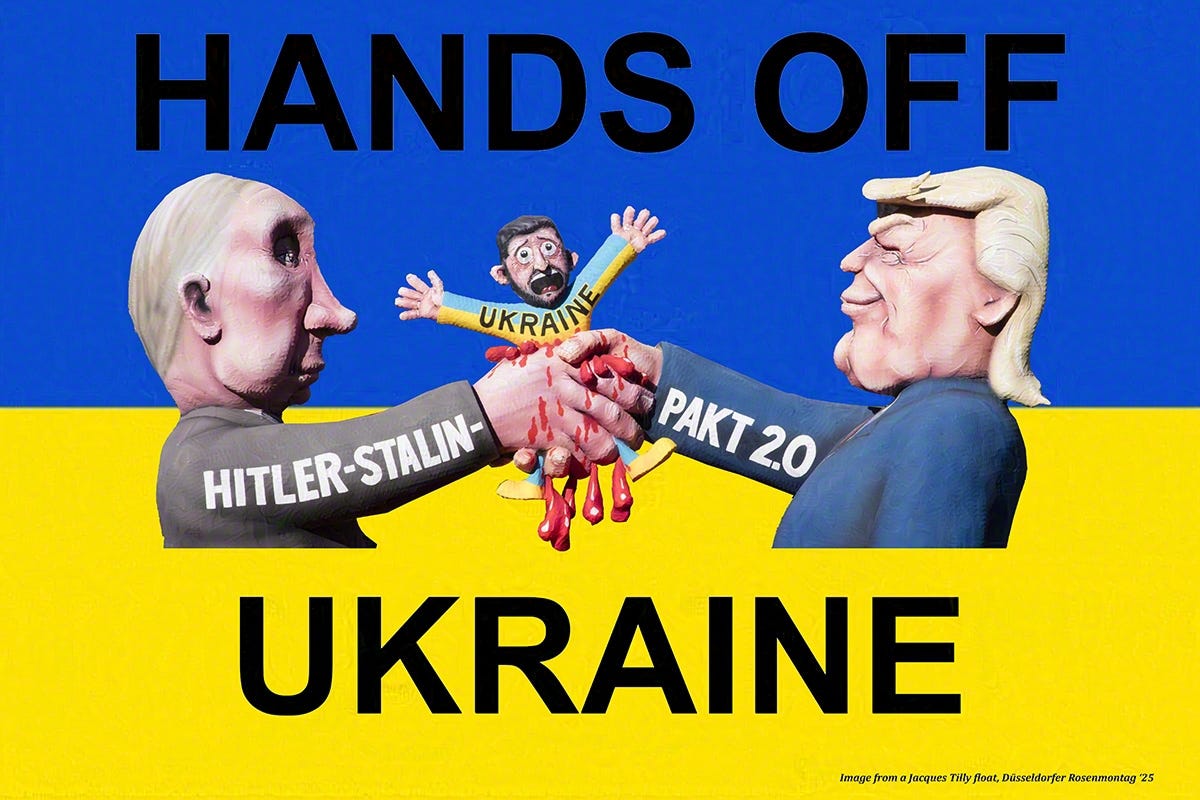I will be at the Washington Monument on Saturday at noon to take part in the Hands Off protest, and hope to motivate others to do likewise, wherever you happen to be, by sharing my two placards (One sign, 17x24 inches, front and back). The first, shown above, includes artwork from a photograph I took of one of Jacques Tilly's most excellent works at the Rosenmontag parade in Düsseldorf earlier this month. (Paid subscribers may recognize it from my earlier post.)
Before showing the second, I want to make it clear that the two issues I'm highlighting are by no means not the only ones I am concerned about. I have chosen these particular two because of a feeling I have that they are not going to be dominant themes, and because I consider them to be existential. So many possibilities, so few signs!
This one features another piece of Jacques Tilly's handiwork, this time from a Greenpeace demonstration at the G20 summit in Hamburg in 2017. I didn't take the picture, and in fact had to cobble it together from parts of two other images I found on the internet. Greenpeace gets a plug because they sponsored Tilly, are one of the sponsors of Hands Off! and are my personal favorite climate justice organization.
The political situation in the US suggests the need for a public outcry sufficiently massive to make Congress more afraid of the electorate than they are of the administration. Research into mass protests by Erica Chenoweth and Maria Stephan as reported by the BBC [1] suggests that, first, nonviolent demonstrations are roughly twice as effective as violent ones in affecting change; and second that nonviolent uprisings involving about 3.5% of the people are highly successful in achieving their ends. As I have not read the book [2] upon which the report is based, I am unsure as to whether the percentage refers to the entire population or some segment of it; for examples eligible or actual voters. In [3] Charles Euchner asserted that for the US, the number is 11.5 million, or 3.5% of the total population (327 million). I highly recommend that anyone who wishes to engage, whether or not in an organized demonstration, read [3] for advice on conduct.
Though the numbers sound daunting, they really aren't. Given that demonstrations will be taking place on April 4th at all 50 state capitals and in numerous large cities as well, if the average turnout at the state houses was 125,000 and that in each of 15 cities was 350,000, the aggregate turnout would be 11.5 million. In doing this calculation I deliberately kept the number of cities low so as to not depend on large turnouts in the big cities in red states like Florida or Texas. With 25 cities the average city turnout decreases to 210,000. Euchner's little lesson on attitude, making the connection between turnout goals and the four minute mile, is worth bearing in mind.
One thing is certain: If we don't use this opportunity to have our voices heard en masse, we are losing what might be our final opportunity to save our democracy, choosing through inaction to hope that others – whoever that might be – will save us.
Notes
[1] Robson, D., The '3.5% rule': How a small minority can change the world. https://www.bbc.com/future/article/20190513-it-only-takes-35-of-people-to-change-the-world
[2] Chenoweth, E. and M.J. Stephan, Why Civil Resistance Works: The Strategic Logic of Nonviolent Conflict, Columbia University Press, 2012 ISBN 9780231156837
[3] Euchner, C., To overthrow a tyrant, try the 3.5 Percent Solution, https://bigthink.com/the-present/the-3-5-percent-solution/





Cursed typo near the end: It's April FIFTH, April 5th.